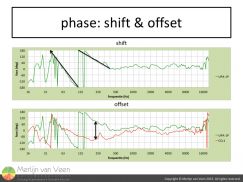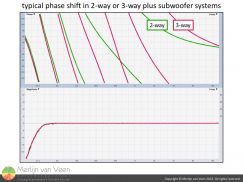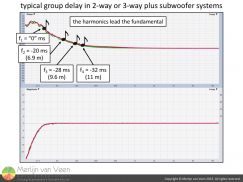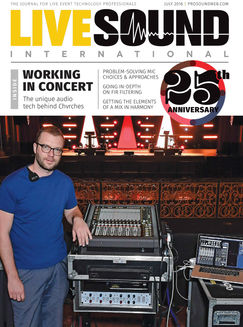 "It turns out that, within very generous tolerances, humans are insensitive to phase shifts. Under carefully contrived circumstances, special signals auditioned in anechoic conditions, or through headphones, people have heard slight differences. However, even these limited results have failed to provide clear evidence of a 'preference' for a lack of phase shift. When auditioned in real rooms, these differences disappear..."
"It turns out that, within very generous tolerances, humans are insensitive to phase shifts. Under carefully contrived circumstances, special signals auditioned in anechoic conditions, or through headphones, people have heard slight differences. However, even these limited results have failed to provide clear evidence of a 'preference' for a lack of phase shift. When auditioned in real rooms, these differences disappear..."
Dr. Floyd Toole
 figure 1As Dr. Floyd Toole states, a lot of people, including myself, have a hard time detecting phase shift. Not to be mistaken with phase offset (figure 1). In the video below you'll see me applying gratuitous amounts of phase shift by means of all-pass filters.
figure 1As Dr. Floyd Toole states, a lot of people, including myself, have a hard time detecting phase shift. Not to be mistaken with phase offset (figure 1). In the video below you'll see me applying gratuitous amounts of phase shift by means of all-pass filters.
After demonstrating with HPF's and LPF's that the plugins are actually doing something, notice how hard it is to hear any differences but for the occasional pop and dropout of my computer trying to keep up. At the end of the video when I switch over from phase to group delay you can see as much as 15 ms of frequency dependent "time smearing" is being added. And that's on top of the inherent phase shift or group delay of your (computer)speakers or headphones you're using to listen to the sound of this video.
That being said, I know of a few people that I hold in high regards e.g. Mauricio "Magu" Ramírez of Meyer Sound and François "Frankie" Desjardins of Solotech, that have been fortunate enough to actually hear real speakers with linear "flat" phase behavior from virtually DC to light.
While doing blind A/B testing, listening to their favorite tracks, between linear phase and minimum phase (typical behavior for the majority of real-world speakers) approaches, initially they detected no differences. But when a given track contained substantial low frequency information e.g. electric bass guitar, drums or deep vocals both of them immediately noticed a difference which can be best described, from what I came to understand, as presence. Where these instruments or voices previously were ambiguous within their frequency range, now they suddenly were up close and personal with focus and impact.
This raised the question as to what, even though it appears we're immune to phase shift, causes this sensation. For now the only answer I can think of, and probably isn't novel, is that in your typical sound system, the harmonics lead the fundamental for low frequency sources. The fundamental allow us to determine pitch and the harmonics (multiples of the fundamental frequency) enable us to distinct violin from clarinet or Willie Nelson from Leonard Cohen. Without harmonics, all sources would be producing pure sine wave fundamentals exclusively and be indistinguishable from each other. figure 2
figure 2 figure 3Figure 2 shows the typical phase shift for a regular (no FIR or APF's) 2-way or 3-way speaker complemented with a non-overlapping, phase aligned (ported) subwoofer. All crossovers are done with 4th order Linkwitz-Riley filters at unity gain. Figure 3 tells the same story but now instead of phase, group delay is shown.
figure 3Figure 2 shows the typical phase shift for a regular (no FIR or APF's) 2-way or 3-way speaker complemented with a non-overlapping, phase aligned (ported) subwoofer. All crossovers are done with 4th order Linkwitz-Riley filters at unity gain. Figure 3 tells the same story but now instead of phase, group delay is shown.
In case of an open E-string (lowest) on a typical electric bass guitar with a frequency of 40 Hz, the 2nd, 3rd and 4th harmonics lead by respectively 20, 28 and 32 milliseconds. That's 7 to 11 meters! Most mixing engineers will tell you that for such instruments the harmonics, which tent to be louder, matter more than the fundamental. In my opinion this is starting to make additional sense from a temporal point of view as well.
However if we were capable of removing this extraneous although minimum amount of phase shift, I would suspect to hear a difference. Having those harmonics synced, as far as the speaker is concerned, instead of (time) smeared, makes for a sharper, more transient leading edge in the waveform which should tighten and clean up the sound.
Flattening the phase can be done, e.g., with FIR filters, in exchange for latency. The duration of the Finite Impulse Response filter needs to be at least twice the period duration of the lowest frequency it’s describing. That’s 100 ms at 20 Hz! Unacceptable
for live sound reinforcement but not for playback situations.
I for one, am hoping to experience it for myself one day.
Music: royalty free track "Hang On Tight" from www.smartsound.com
 figure 4This article is also featured in the July 2016 edition of Live Sound International magazine (figure 4) which can be downloaded below.
figure 4This article is also featured in the July 2016 edition of Live Sound International magazine (figure 4) which can be downloaded below.
